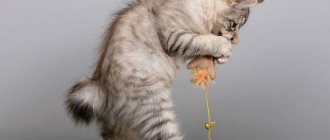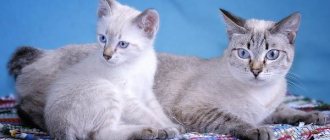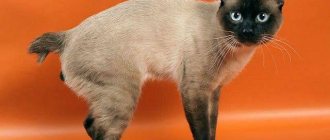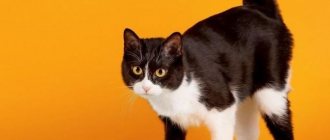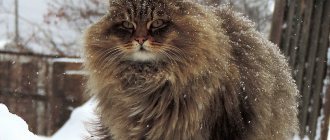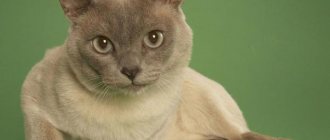The very nature of Sakhalin and the Kuril Islands played a role in the breeding of cats of the Kuril Bobtail breed. These animals got their name from a geographic location and reflected in their appearance the wild and harsh beauty of the Far East. The description, characteristics of the breed and other interesting information about these cats will be useful to beginners and experienced fans of furry creatures.
Description of the Kurilian Bobtail breed
Popularity 77th place among 86 cat breeds
Lifespan:
12-15 years
Height:
up to 30 cm
Country of origin:
Russia
Average price:
10-20 thousand rubles
Weight:
up to 7.5 kg
Latest articles Cat care
How to trim a cat's claws correctly and easily 01/28/2022 139 0 0
Dog health
How to do an ultrasound for dogs: preparation and procedure 01/28/2022 63 0 0
Key facts
The main characteristic of the Kurilian Bobtail is its tail. Outwardly, it resembles a fur ball. This trait was inherited by the breed from its Japanese neighbors.
Despite the fact that cats are proud creatures by nature, they are seriously attached to the family in which they live, but they can only have one owner. Do not pay attention to the similarity of these cats with wild predators. They are friendly and playful by nature.
Bobtails will only be welcome for children in the house. Don't want your child to be bored alone? The Kurilian Bobtail cat will take part in any game. Bobtails also treat other pets leniently, however, given their cat-like nature, you should still not let ornamental birds or rodents get close to them.
Be prepared for the fact that from time to time the bobtail will test your nerves and show excessive nobility and willfulness. Do not succumb to the furry's provocations, otherwise he will lose respect for you. The description of the Kuril Bobtail breed explains its dominance by the conditions in which the breed was bred.
The health and life expectancy of the Kuril Bobtail are encouraging: seals live up to 15 years, and there are also those individuals that have reached the 17-18 year mark.
Common signs of bobtail cats
There are several types of bobtail cats on earth today. They are all united according to several main characteristics:
- A short small tail measuring approximately 2 to 12 centimeters;
- Sufficiently long (longer than the front) and strong hind legs;
- Quite a low timbre of voice;
- No need to mark territory (unless two competing cats live in the same apartment);
- Muscular physique.
It is also worth noting the special character that distinguishes all cats of the breed: they are all fearless, well adapted to life in the wild, and able to stand up for themselves. But at the same time they have a devoted, almost dog-like heart. They become attached to the owner, and not to the place, they love him with all their cat soul. They lend themselves very well to classical training, the “fetch” command is easy to execute, and these amazing cats feel quite comfortable on walks, even if the owner walks his pet on a leash.
History of the origin of the Kuril Bobtail
The southern part of the Kuril Islands is a well-known place. For many years, Japan and Russia defended their rights in this territory. However, the Russian Federation still remained their rightful owner. The country received not only a piece of land in the Far East, but also the right to be considered the homeland of one of the most unusual cat breeds.
Most felinologists believe that bobtails descended from those short-tailed cats that inhabited the islands since the 18th century. Their distant relatives were wild cats, which appeared thanks to the union of Siberian cats and Japanese bobtails. Their story also deserves special attention.
In Japan, bobtails are considered a symbol of good luck, as evidenced by ancient beliefs. People treat representatives of this breed with respect, give them to each other on major holidays, and sometimes even overprotect them. The origin of these animals is no less sacred. Their ancestors are considered to be white cats that lived in temples and guarded the followers of Buddha.
The Japanese often brought their animals to the Kuril Islands as part of military or other expeditions. They were even used as guards on farms where fur-bearing animals were bred. However, cats are not animals that will obey in everything. They are too proud for this. It is for this reason that many Japanese bobtails simply ran away from their owners into the wild nature of the Kuril Islands.
Generations passed, and bobtails acquired new features that helped them adapt to the harsh nature. Now these cats were no longer afraid of water, their claws were no longer hidden in soft paws, and the animals themselves became much larger, which allowed them to hunt larger game.
Siberian cats came to these lands along with settlers. They made friends surprisingly easily with their Japanese brothers, who by that time had completely gone wild. Time passed, the breeds mixed until the familiar Kuril Bobtails saw the light of day.
However, local residents did not immediately notice that a new breed had formed literally before their eyes. Therefore, the selection of Kuril Bobtail cats began a little later. Felinologists paid attention to the Kurilians only towards the end of the 20th century. Until this time, bobtails were mistaken for Japanese cats. No one knew then that those same furry creatures were not just feral cats from the Land of the Rising Sun, but truly something new in the already diverse fauna of the earth. But in 1991 everything changed dramatically.
At this time, the first breed standard was formed from cats brought from the Kuril Islands by the Soviet felinological organization. Tatyana Bocharova played an important role in this. She conducted research and found that the short tail of the bobtail is inherited by absolutely all descendants, which means that this is not a genetic anomaly, but a full-fledged feature of the breed.
So Kuril cats were officially registered as a separate breed in the Siberian Federal District. However, this was not enough. Now there was another question - how to achieve recognition from European organizations?
In 1994, a seminar was held at which Russian breeders asked how to refine the breed standards and achieve recognition from the international organization WCF. A year later, the breed received its recognition, and with it an explosive flurry of interest among Europeans. Bobtails have become frequent guests of exhibitions in the Czech Republic, Poland, Italy and many other countries. Nurseries opened everywhere, breeding both short-haired representatives of the breed and long-haired ones. However, the long-haired representatives quickly divided into cats with long and semi-long hair.
In 2001, the standard of the Kuril Bobtail was once again clarified, but overall remained unchanged. In 2012, the FIFe organization officially approved the independent Kuril Bobtail breed. In the same year, the breed appeared on the TICA lists.
To this day, bobtails appear in more and more places, winning the hearts of more and more people. These cats are highly valued in Europe for their kindness and devotion, and in the east, bobtails have become integral companions of hunters and fishermen, who were able to fully appreciate the hunting qualities of fluffy cats.
History of the breed
It is believed that Kuril Bobtails have lived on the Kuril Islands since the 8th century AD. However, they came to Russia quite recently - in the 90s of the last century. They were brought to the mainland by Russian research scientists, and breeders began breeding them. At the beginning of this century, an international federation and club of bobtail lovers appeared.
Now specialized nurseries exist in various countries of the world. The Kurilian Bobtail is a close relative of the Japanese Bobtail.
In conclusion, we will dispel some myths about Kurilian Bobtails.
What does a Kurilian Bobtail look like?
The appearance of the bobtail is contrasting. Although he is not tall enough, his muscles are the envy of any other cat. Thanks to its strong muscles, the animal can run very fast and make incredible jumps. It is very easy to distinguish a female bobtail from a male, because the breed has highly developed sexual dimorphism: males are several centimeters taller than females and 2-3 kilograms heavier. In the photo of the Kurilian Bobtail you can immediately see what gender the animal is.
Muzzle
The bobtail's head is triangular, with rounded corners. The whisker pads are well defined and quite dense. The skull is flat.
The muzzle is wide and round in shape. The stop is poorly marked and almost invisible. The forehead is flat, smoothly transitioning into a wide, short nose. Its lobe is quite large and well defined. The chin is strong, with smooth outlines that are clearly visible in profile. The cheekbones are low, but not as much as in Siberian cats.
The ears are triangular, not too large. Planted far apart, high. The distance between the ears should be equal to the width of the ear itself. It may be a little more, but less is unacceptable. At the tips of the ears there are small tassels-decorations. This gives them a lynx-like appearance.
The eyes are slightly slanted, inherited from their eastern ancestors. This gives them a unique aesthetic and mysterious look. The eyes are set quite wide, on the same line. The color of the iris can be green or yellow. In the case of two-color representatives, blue eyes are acceptable. Eye color is not strictly regulated by the standard.
During the time that Japanese bobtails lived in harsh Siberia, they acquired powerful jaws. Their bite is pincer-shaped, with a full set of teeth.
Body type
What does a Kurilian Bobtail look like? His neck is covered with thin skin, under which powerful muscles are hidden. Due to the compacted coat in this area, it appears that the bobtail has a wide neck.
The body is dense, strong, however, which is typical for all types of cats, very flexible and pliable. The body is elongated, the back is arched, the croup is slightly raised.
The main distinguishing feature of the bobtail is its tail. It rises above the back. Its length varies from 3 to 13 cm depending on the length of the animal’s fur. However, even such a short tail has 4 varieties:
- The “stump” is assembled from vertebrae tightly adjacent to each other. It can either be held straight or be bent down with a hook;
- “broom” – 5-10 vertebrae, straight. 1/3 smaller than a regular tail;
- “spiral” is one of the most common among bobtails;
- The “retracted bobtail” includes 5-7 vertebrae that curl into a loop towards the tip of the tail. Considered a defect.
The shape of the pompom itself is not limited in any way in the standard, so it can and even needs to be trimmed periodically. The varieties of the Kuril Bobtail are not distinguished on this basis.
The hind legs of bobtails are much longer than the front legs. Their developed muscles allow cats to jump long distances. Bobtail paws are round, with tightly clenched toes. The claws do not retract into the pads, which is why the cat makes a scratching sound when walking, characteristic of dogs.
Coat and color
Kurilian Bobtails are divided into two types based on the length of their coat:
- Short-haired representatives have fine wool. On the tail it may be longer than on the rest of the body.
- Long-haired cats, accordingly, have longer or medium-length hair. But even they may have longer hair in the lower part of the body and on the tail. In addition, they have a puffy “collar” and “pants”.
The color of the Kurilian Bobtail can be almost any color. There are several common varieties: smoke, tricolor and tabby. The breed standards do not include chocolate, lilac, Abyssinian and Burmesse colors.
Description and appearance
The bobtail's head is large by standard, wide at the cheekbones. The eyes are oval shaped. Ears tilt forward.
Kurobobs have a rectangular muzzle and whisker pads are clearly visible. The nose is wide at the base, straight in shape, of medium length.
According to the characteristics, females of this breed are larger than males. Females weigh up to 9 kg, males - up to 5 kg.
The bobtail's head is large as standard, wide at the cheekbones
The body is distinguished by strong bones with developed muscle mass. The breed accepts short-haired and semi-long-haired varieties. Any color (black, red, blue, cream, etc.), and the number of white spots varies.
The cat's unusual tail is the calling card of the breed.
There are 4 types of tails:
- Stump - represents 2 vertebrae, fixedly connected to each other.
- Spiral - the tail consists of 3-15 vertebrae, twisting into a kind of spiral. This is one of the most common types.
- Panicle - the vertebrae are located movably or semi-movably among themselves. The tail curves form an obtuse angle.
- Retracted - tail of 5-8 vertebrae, without bends. The vertebrae have varying mobility, the latter forming a spiral at the tip of the tail.
Character of the Kurilian Bobtail
Although Kurilian Bobtails may look wild, they are actually famous for their kindness and friendliness. Even with a change of owners, the bobtail quickly gets used to the new owners. He will not sit with a sad face under the bed until you pull him out of there, but on the contrary, he will come up to you to get acquainted.
These cats are active and love when all family members participate in games. Sometimes they look more like dogs: after all, they also like to fetch toys that the owner throws for them.
This cat will love his family as devotedly as a dog would. Nothing is more important to him than his family. The animal will protect the family by taking a threatening pose and meowing menacingly. Well, the owner of the bobtail has a special place. If you are lucky and a furry guard has chosen you as his owner, be proud of it. Now he will accompany you everywhere and become an integral part of your life.
The bobtail has no complaints about other pets. He will happily share his home with either another cat or a dog. However, this does not apply to birds and rodents, which the cat will perceive exclusively as prey. A suddenly heightened natural instinct can lead to unpleasant consequences.
Although this baby looks kind and harmless, be prepared for his outbursts of pride and independence. The bobtail will definitely not want to sit in your arms for a long time, because this is not a plush toy, but a real hunter. If the owner does not pay enough attention to the animal, then soon the cat will simply begin to live by its own rules, feeling like the master of the house.
If this happens, it will not be easy to overthrow the furry tyrant from his throne. You will encounter cat protest and harmfulness. He is unlikely to limit himself to torn curtains, damaged things and broken dishes. The character of the Kurilian Bobtail will deteriorate if the owner devotes insufficient time to raising it.
Has the cat become completely lazy and almost doesn’t want to play with you anymore? Take it with you on a hike or to the countryside! There you will see your pet in a completely different light. In the fresh air, the animal will quickly remember all its hunting roots. Now there will be no time to lie on the couch all day long, because you have to catch butterflies, fight with the neighbor’s cats, and explore the territory.
Raising a Kurilian Bobtail
Nature has not deprived bobtails of intelligence. A cat can not only guess your mood, but also understand what you are talking about. Raising such a cat is not difficult, but it is important to clearly define the boundaries. Do not hit the cat under any circumstances; it is better to explain to him that he is behaving inappropriately, in some other way. Teach him the word “no”. This will help you a lot in the future.
If your pet does violate any of the rules, have an educational conversation with him. It is important to do this as quickly as possible after committing a “crime”, otherwise the cat simply will not understand you.
As soon as the pet has matured, it begins to test the strength of its owner’s nerves and tries to take the place of the boss in the house. At this time, it is important to let him understand that you do not intend to give up your place to him, moreover, for disobedience he will be punished in the same way as always.
For people with a strong character, raising a bobtail will not cause any problems. The cat will quickly get used to the tray and scratching post and will not cause any problems.
Bobtails are also quite easy to train. Curiosity and activity help them in this. They are able not only to learn together with their owner, but also to learn from the experience of their own kind. The main thing is to make a game out of training, and then the cat will surprise you with its success.
Looking for a Kurilian Bobtail? Find your pet from 2 offers Buy
Advantages and disadvantages of the breed
Advantages of the Kuril Bobtail:
- attractive appearance;
- playful nature;
- good nature;
- kindness;
- equilibrium;
- obedient character;
- intelligence;
- tendency to train;
- absence of problems in education;
- cleanliness;
- lack of aggression towards children;
- ease of care.
The Kurilian Bobtail is so wonderful that I don’t even want to talk about its shortcomings. Some owners don't like their cats' tendency to dominate, but this can be attributed to improper upbringing.
Health of the Kurilian Bobtail
Possible diseases
Due to the fact that the ancestors of bobtails lived in snowy Siberia, these cats have excellent immunity. The health of the Kurilian Bobtail is enviable. However, there are several diseases that are common among this breed:
- haemorrhoids;
- rectal prolapse;
- cracks and inflammation of the anal mucosa;
- urolithiasis disease.
These cats are also not immune from infectious or parasitic diseases, so it is very important to get vaccinated on time and visit a veterinarian.
Reproductive health
A bobtail can be sterilized only after reaching 12 months. Some representatives have a hard time with anesthesia and can recover from it within several days. If you decide not to sterilize your cat, but to breed offspring, then keep in mind that a bobtail litter usually has from 3 to 8 kittens.
Features of feeding and diet
Bobtails are completely unpretentious in food. But you shouldn’t feed him table scraps either. For a cat who regularly participates in exhibitions, the best food will be premium food. If your pet does not win medals and titles, regular food with the addition of boiled meat and vegetables will do.
There are several things that you should not feed to a representative of this breed:
- eggplants, potatoes, any legumes;
- fish;
- sweets;
- raw or fried meat;
- dairy products;
- fatty meat (pork, lamb).
You can give your pet water. If you use tap water, it needs to sit for at least 24 hours.
Sterilization and castration
If the cat is not intended for breeding, the best solution would be spaying and neutering. These are simple operations, they are performed in every veterinary clinic. They are performed under general anesthesia and cause minimal suffering to the cat. The rehabilitation period is short and well tolerated by animals.
Experts do not recommend special hormonal drugs that suppress sexual desire. The consequence of taking them may be the development of malignant tumors and cysts.
Care and maintenance
Thanks to the undercoat, cats' fur rarely gets tangled, which means it does not need daily brushing. It is enough to comb out dead cat hair once or twice a week to prevent it from spreading throughout the house. This can be done either using a comb with metal teeth or using a special glove. Do not scratch your cat against the grain: this will damage its structure and create unpleasant sensations for your pet.
Bobtails love to swim, but you should not do this procedure too often. The animal's skin may dry out and the hair coat may become too thin. Neither a special conditioner nor a mild shampoo will help. Only take baths when your pet needs it. Don't forget that cats are not dogs; they never miss an opportunity to get a good lick. Don't neglect a towel after showering. Even the slightest draft for a wet baby can cause illness. It is recommended to dry the cat with a hairdryer.
Bobtails cannot fully retract their claws. However, you don't have to worry about your pet accidentally scratching you. The claws wear down while walking and also when the cat uses a scratching post. Of course, it wouldn’t hurt to purchase special nail clippers. Trim your cat's claws very carefully, otherwise you risk damaging the blood vessels in them.
Check your cat's eyes regularly for dirt. They need to be washed two to four times a week, using a special solution sold in pet stores. Don’t forget about your pet’s ears, wiping them with a cotton pad with a special lotion. If this is not done, wax will accumulate in the cat's ears, which can cause infectious diseases.
You need to brush your cat's teeth at least once a week. Never use human toothpaste. To avoid torturing yourself and your pet by using a regular toothbrush, get a special thimble with bristles. In general, caring for and maintaining the Kurilian Bobtail will not cause much trouble.
What to feed a handsome bobtail
Until the kitten reaches three months of age, it is recommended to eat 6 meals a day. At six months the number of feedings should be reduced to 4 times, and at 9 months the pet can be transferred to an adult feeding regimen - 2 times a day. You can feed your bobtail both natural products and ready-made industrial food.
Table: natural products that must be in a cat’s diet
| Product | Feeding frequency |
| Raw frozen beef - at least 30 grams for a kitten, 100-120 grams for an adult cat. | Every day. |
| Boiled chicken without bones | 3–4 times a week. |
| Chicken or beef by-products (heart, lungs, liver, kidneys) raw (frozen) or boiled. | 2–3 times a week. Liver - once a week. |
| Boiled low-fat fish, without bones, preferably sea fish (rarely, because fish destroys vitamin B in the cat’s body). Raw fish should not be given - it leads to the appearance of worms. | Cats - 1-2 times a week, cats - 1 time a week or less. |
| Egg yolk (whites should not be given) raw or boiled in pure form; You can grind it with milk, kefir, or add it to porridge. | 1–2 times a week. |
| Goat's milk, fresh, raw or boiled, or dried from a veterinary store (only for kittens under 3 months, because an adult cat cannot digest milk and causes an upset stomach, but a kitten needs it). You can add a little honey (no sugar). Also given to pregnant and lactating cats. | You can switch to fermented milk products every day if you have an upset stomach. |
| Liquid milk porridges (for kittens under 3 months of age): semolina, rice, oatmeal. No sugar, maybe a little honey. | You can do it every day. |
| Fermented milk products: kefir, sour cream, fermented baked milk, yogurt, cream - all of medium fat content, as well as cheese. | You can do it every day. Cheese once a week. |
| Fresh, non-acidic cottage cheese - you can mix it with sour cream or raw egg yolk (you can add just a little honey). | Kittens - 3-4 times a week. Adult cats - 1-2 times a week. |
| Cereals: oatmeal (steamed), rice, buckwheat, wheat grits (boiled) - mixed in a 1:2 ratio with boiled meat or boiled fish. | Few times a week. |
| Vegetables, raw or boiled (in the form of puree): carrots, cauliflower, green (asparagus) beans, etc. - mixed in a 1:2 ratio with boiled meat or boiled fish. | Several times a week (alternate with cereals). |
| Greens - lettuce, spinach - are chopped and added to food. It’s better to use sprouted wheat grains or grow grass on the windowsill (from wheat or oats). NO grass from the street! | Add to food several times a week; if there is grown grass, the cat will eat it itself. |
In some sources you can find information that it is better not to give fish to cats. However, in the natural habitat of the Kuril Bobtail, fish was an important part of their diet. And my personal experience is that fish in moderation in the diet of a healthy cat will not harm it. I often fed my cats fish, and none of them had kidney problems.
The following foods are prohibited:
- food from the human table;
- salty, fried, smoked, sweet food;
- pork, lamb;
- goose, duck;
- spleen, chicken necks and bones;
- seafood;
- cream, sour cream, butter, salted cheese;
- citruses, kiwi, pineapple;
- persimmon;
- rhubarb;
- nuts;
- beans;
- potatoes, broccoli;
- onion garlic;
- tomatoes, eggplants;
- mushrooms;
- chocolate;
- Tea coffee;
- alcohol;
- bread and other baked goods.
The proportion of proteins, fats and carbohydrates should look like this: 60–70% protein, 10% fat and 20–30% carbohydrates. It is best to check with your veterinarian for serving size.
There are 2 ways to determine the required amount of food:
- measuring portions with scales at the rate of 5–7% of the cat’s weight;
- determining the amount of food by observing the animal (a contented purring cat is a sign that it is full).
On the one hand, the second method of determining the portion size is optimal, since each animal has a different appetite. But on the other hand, this can lead to obesity of your furry pet. In my opinion, it is still better to use the first method.
Ready-made feed
Ready-made food is divided into dry and canned. It is better to give preference to the latter, as they are considered more beneficial for cat health. But often bobtails choose to eat dry food, as experienced breeders say.
In any case, you can feed your bobtail only with premium industrial food, since cheaper products cannot always sufficiently satisfy the needs of this animal.
Often on cat forums you can witness heated debates regarding the combination of natural food with dry and canned food. Some breeders insist that it is possible to mix all types of feeding - this only benefits the cats. But others are categorically against this, because they believe that such a combination of food can lead to serious health problems. In order not to harm your pet’s health, this issue should be resolved only with a specialist.
Nutritionists do not recommend combining industrial food with homemade food, but some specialist doctors and, more often, breeders, argue that industrial food should not form the basis of a cat’s diet, they can be given as an additive to the main diet, and their opinion boils down to the fact that industrial feed, both dry and liquid, should make up no more than 25% of the main diet. Others hold a diametrically opposite opinion - the introduction of natural products should not exceed a quarter of the amount of industrial feed, which is the basic one in the diet structure. The specialists of our clinic do not agree with this position, both the first and the second - this introduces an imbalance in the diet, provokes instability of digestion, and the whims of the cat. When layering natural meat additives, it often provokes not only the whims of the cat, but also an imbalance of food in ballast substances with a tendency to form constipation, and there is also a violation of calcium metabolism due to a lack of calcium and excess phosphorus in meat products, which leads to the need for corrective input of additional the amount of fiber in the form of bran or vegetables and mineral supplements. The only argument in this case can only be the underestimated amount of high-quality protein in industrial feed and the intensive growth of the animal, but again, when using high-quality food appropriate for the age of the animal, such problems are unlikely. Adding industrial feed to the main “natural” diet makes no sense at all, while such an introduction of industrial feed not only does not correct the main diet, but only introduces additional complexity into balancing the main diet.
Chermoshentseva Galina Vladimirovna, chief veterinarian of the UNIVER-West veterinary clinic
https://www.vet-univer.com/content/articles/index.php?ELEMENT_ID=349
The serving size must comply with the standards indicated on the packaging; only a veterinarian can adjust it. It should be noted that for kittens it is necessary to buy special food intended specifically for them.
To avoid overfeeding your pet, you need to monitor the portion size
Tips for choosing a kitten
Purchasing a kitten of this breed is a responsible step. Carefully study all the kittens in the litter and choose the one that suits you best. Neither your friends nor the breeder will help you in this matter, so you should not listen to their words. They cannot know what kind of pet you need.
You should buy a kitten at about three months of age. At this age, the bobtail is already learning to be independent and not dependent on its mother. The kitten’s psyche is sufficiently developed to adapt to new conditions and owners.
If the pedigree of your future pet is important to you, ask the breeder for documents, achievements, and certificates. It would also be a good idea to meet the parents in person. If the breeder is silent and does not express a desire to fully answer your questions, this is a sign that he has something to hide.
Pay attention to the kitten's behavior among its siblings. If he actively plays with them and shows genuine interest in you, then you can be sure that this is your baby. Lethargic or timid Kurilian Bobtail kittens may grow up hysterical and unsociable in the future.
How much does a Kurilian Bobtail cost?
Ideally, it is better to buy a kitten in a nursery, where you will be provided with complete information about it and given all the necessary documents. The minimum price of a Kuril bobtail is 8,000 rubles, this figure can reach 20,000-25,000 rubles. However, do not forget that this price also includes the prestige of the nursery and the kitten’s parents.
For a slightly higher price, they can bring you a pet straight from the Kuril Islands, where the breed’s homeland is located, but in this case it will be impossible to trace its pedigree. However, this will not prevent the fluffy from becoming your devoted friend.
Do you like the article? 0
Where to buy and how much it costs
If you wish, you can buy a purebred Kuril Bobtail in the famous kennel “Golden Mean”, located in Moscow. They can also be purchased in any large Russian city, since nurseries for “Kurilov” lovers are available almost everywhere. In Ukraine, these cats can be purchased at the famous “Moreman”. And in Belarus they are sold in the Geppy Gunter nursery, which is located in Minsk.
The price of a kitten of such an unusual breed directly depends on its color, class, place of sale, and also on its pedigree (that is, whether it has direct “Kuril” ancestors). Depending on these reasons, its cost can vary from 2 thousand to 16 thousand rubles.
KURILIAN BOBTAIL //IS IT WORTH OWNING? // my experience

